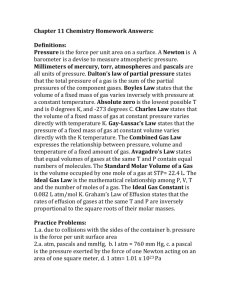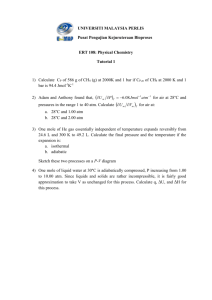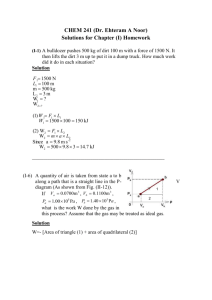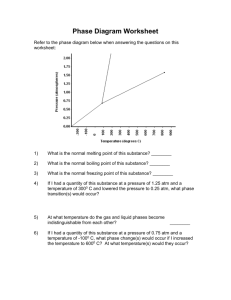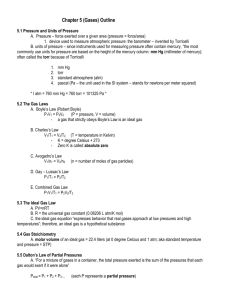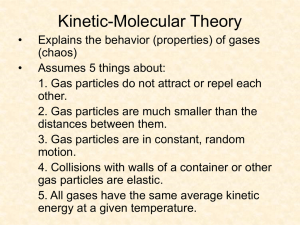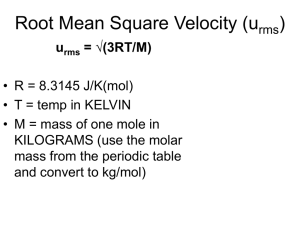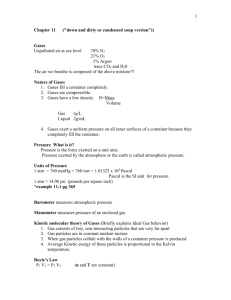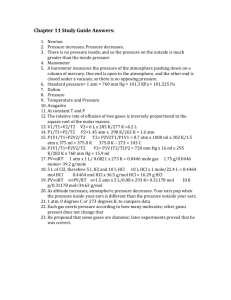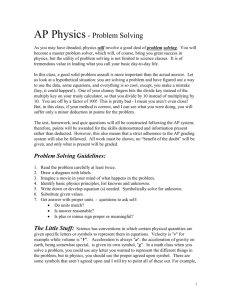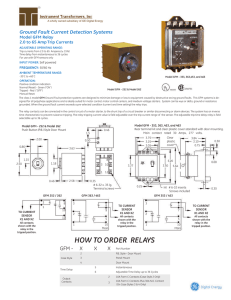GAS LAWS Equation Sheet
advertisement
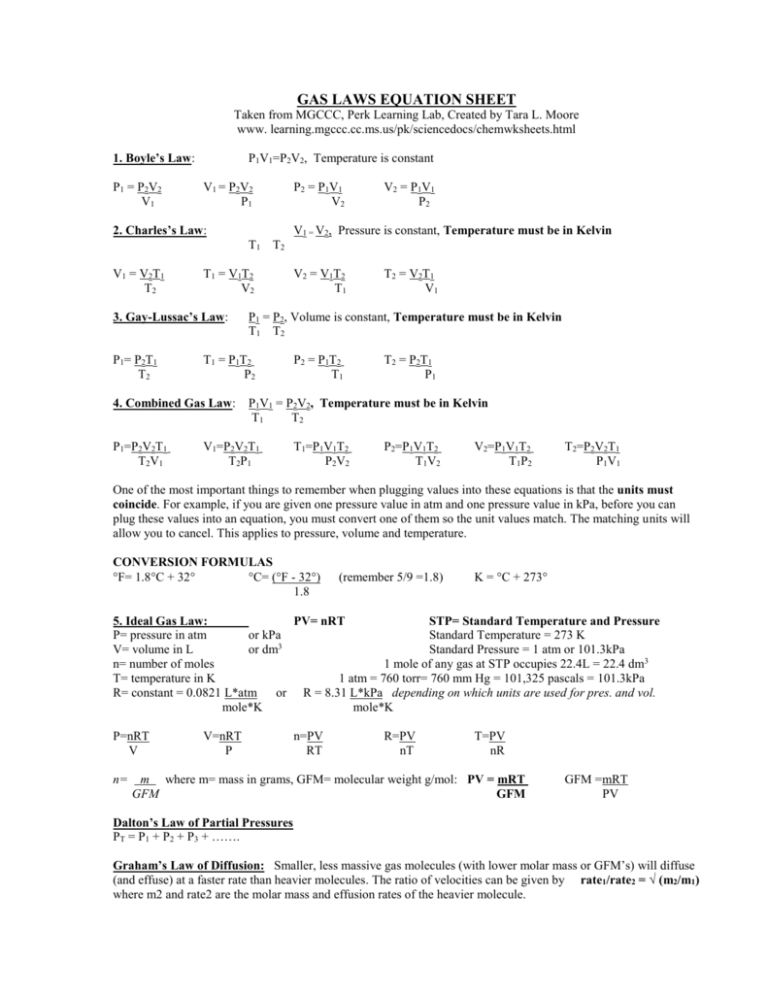
GAS LAWS EQUATION SHEET Taken from MGCCC, Perk Learning Lab, Created by Tara L. Moore www. learning.mgccc.cc.ms.us/pk/sciencedocs/chemwksheets.html 1. Boyle’s Law: P 1 = P 2V 2 V1 P1V1=P2V2, Temperature is constant V1 = P2V2 P1 2. Charles’s Law: P2 = P1V1 V2 V2 = P1V1 P2 V1 = V2, Pressure is constant, Temperature must be in Kelvin T1 T2 V1 = V2T1 T2 T1 = V1T2 V2 3. Gay-Lussac’s Law: P1= P2T1 T2 P1=P2V2T1 T 2V 1 T2 = V2T1 V1 P1 = P2, Volume is constant, Temperature must be in Kelvin T1 T2 T1 = P1T2 P2 4. Combined Gas Law: V2 = V1T2 T1 P2 = P1T2 T1 T2 = P2T1 P1 P1V1 = P2V2, Temperature must be in Kelvin T1 T2 V1=P2V2T1 T2P1 T1=P1V1T2 P2V2 P2=P1V1T2 T1V2 V2=P1V1T2 T1P2 T2=P2V2T1 P1V1 One of the most important things to remember when plugging values into these equations is that the units must coincide. For example, if you are given one pressure value in atm and one pressure value in kPa, before you can plug these values into an equation, you must convert one of them so the unit values match. The matching units will allow you to cancel. This applies to pressure, volume and temperature. CONVERSION FORMULAS F= 1.8C + 32 C= (F - 32) 1.8 (remember 5/9 =1.8) K = C + 273 5. Ideal Gas Law: PV= nRT STP= Standard Temperature and Pressure P= pressure in atm or kPa Standard Temperature = 273 K V= volume in L or dm3 Standard Pressure = 1 atm or 101.3kPa n= number of moles 1 mole of any gas at STP occupies 22.4L = 22.4 dm3 T= temperature in K 1 atm = 760 torr= 760 mm Hg = 101,325 pascals = 101.3kPa R= constant = 0.0821 L*atm or R = 8.31 L*kPa depending on which units are used for pres. and vol. mole*K mole*K P=nRT V n= V=nRT P n=PV RT R=PV nT T=PV nR m where m= mass in grams, GFM= molecular weight g/mol: PV = mRT GFM GFM GFM =mRT PV Dalton’s Law of Partial Pressures PT = P1 + P2 + P3 + ……. Graham’s Law of Diffusion: Smaller, less massive gas molecules (with lower molar mass or GFM’s) will diffuse (and effuse) at a faster rate than heavier molecules. The ratio of velocities can be given by rate1/rate2 = √ (m2/m1) where m2 and rate2 are the molar mass and effusion rates of the heavier molecule. Gas Laws in Words…starting with units of pressure Units of Pressure Avg Atmospheric Pressure (atm) sea level Pascal (Pa) = S.I. unit mmHg Torr (same as mm Hg) Pounds per square inch (psi) STP = std temp and pressure Pressure Conversions 1 atm is Standard Pressure 1 atm = 101.3kPa 1 atm = 760 mm Hg 1 atm = 760 Torr 1atm= 14.7 psi 0ºC and 1atm Kinetic Theory of Gases and Common Terminology Gases are made of separate individual particles (called molecules) in continuous random motion. There are two pressures working in opposition to each other: pressure exerted by the gas (onto the surface of the container) and pressure exerted on the gas (by atmospheric pressure or external pressure applied by a machine, person, etc. Atmospheric pressure can be a very powerful force and is known to be 1atm, 101.3kPa, 760mmHg, 760Torr, or 14.7psi. An ideal gas is a “perfect gas” which follows all the laws above. For ideal gases we assume negligible volume, no attractive or repulsive forces, and perfectly elastic collisions (no loss of energy). A real gas would never behave as an ideal gas under all conditions of temperature and pressure (gases are ideal only under ordinary conditions). 1. Boyle's Law: Gas volume varies inversely with pressure. As pressure increases , volume decreases. As pressure decrease, volume increases. 2. Charles's Law: Gas volume varies directly with temperature. As temperature increases, volume also increases. As temperature decreases, volume also decreases. 3. Gay-Lussac’s Law: Gas pressure varies directly with temperature. As temperature increases , the pressure exerted by the gas increases. (increases kinetic energy) As temperature decreases, the pressure exerted by the gas decreases.(decreases kinetic energy) 4. Grahams Law of Diffusion/Effusion Smaller, less massive gas molecules (with lower molar mass or GFM’s) will diffuse (and effuse) at a faster rate than heavier molecules. Diffusion is the natural movement of gases from high concentration to low concentration. Effusion is a special case of diffusion through a tiny opening in a container. Graham actually studied effusion and determined that the rate of effusion is inversely proportional to the square root of its molar mass. Thus the ratio of velocities can be given by v1/v2 = √ (m2/m1) where m2 and v2 is the mass of the molecule with the largest molecular mass (GFM). 5. Avogadro's Law Equal volumes of gases (at the same temperature and pressure) contain equal numbers of particles. At STP, the volume of gas is 22.4 Liters and the number of particles is 6.02 x 10 23. 6. Dalton's Law of Partial Pressures In a mixture of gases, the total pressure is equal to the sum of the pressures that each gas would exert by itself. Ptotal = Pa + Pb + Pc 7. Ideal Gas Law (also called the “perv-nert” equation) PV = nRT Used to find the number of moles in a sample of gas. This equation allows us to go from macroscopic measurements of P, V, and T and calculate microscopic values such as moles (which can then be used to get molecules or mass). P=pressure, V=volume, n= number of moles, T=temp. in Kelvin, and R= Universal gas constant R = 0.0821 (L*atm) or R = 8.31 (L*kPa) mole*K mole*K 8. Combined Gas Law This is a combination of the first 3 laws when all 3 variable can change and none of them remain constant.
